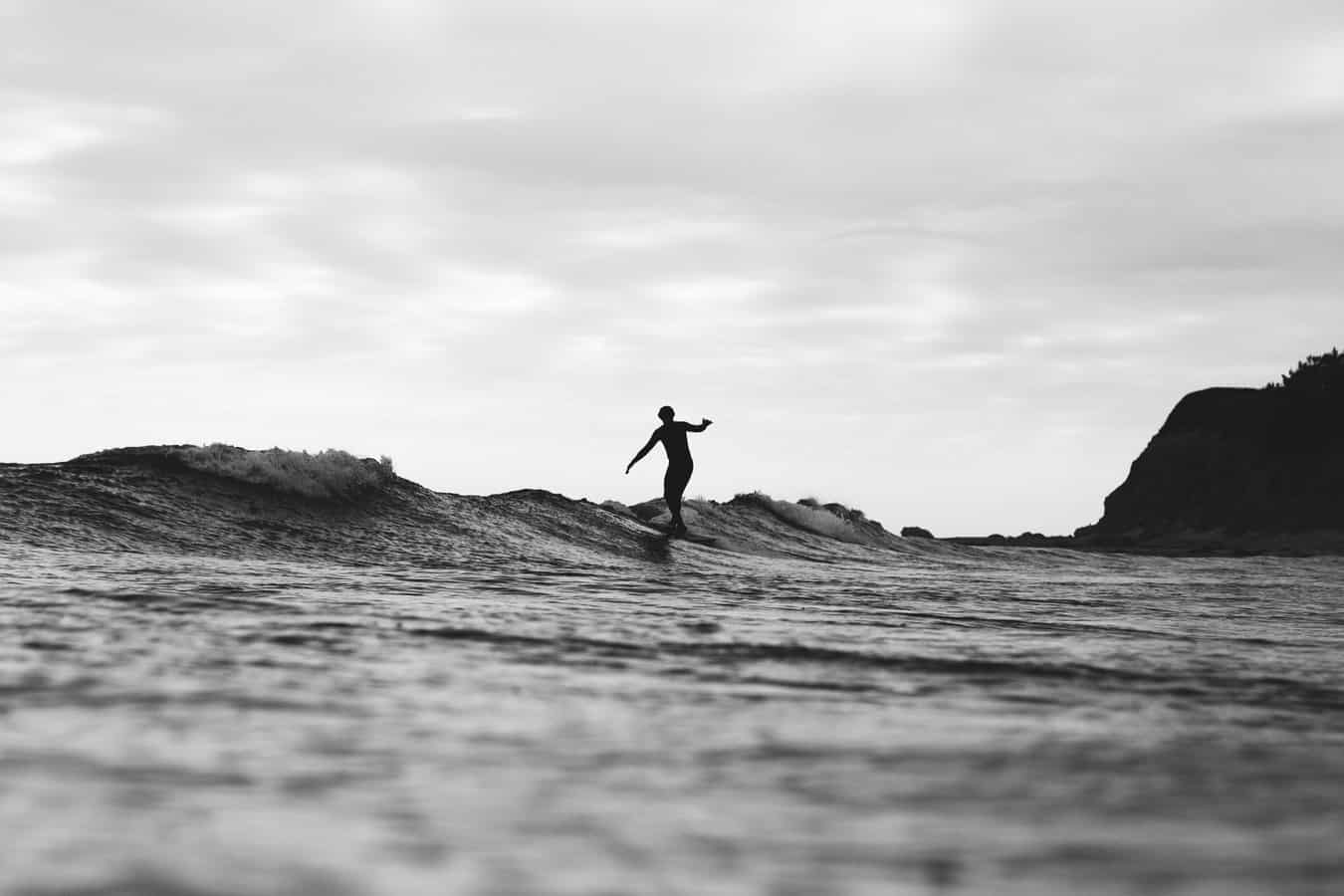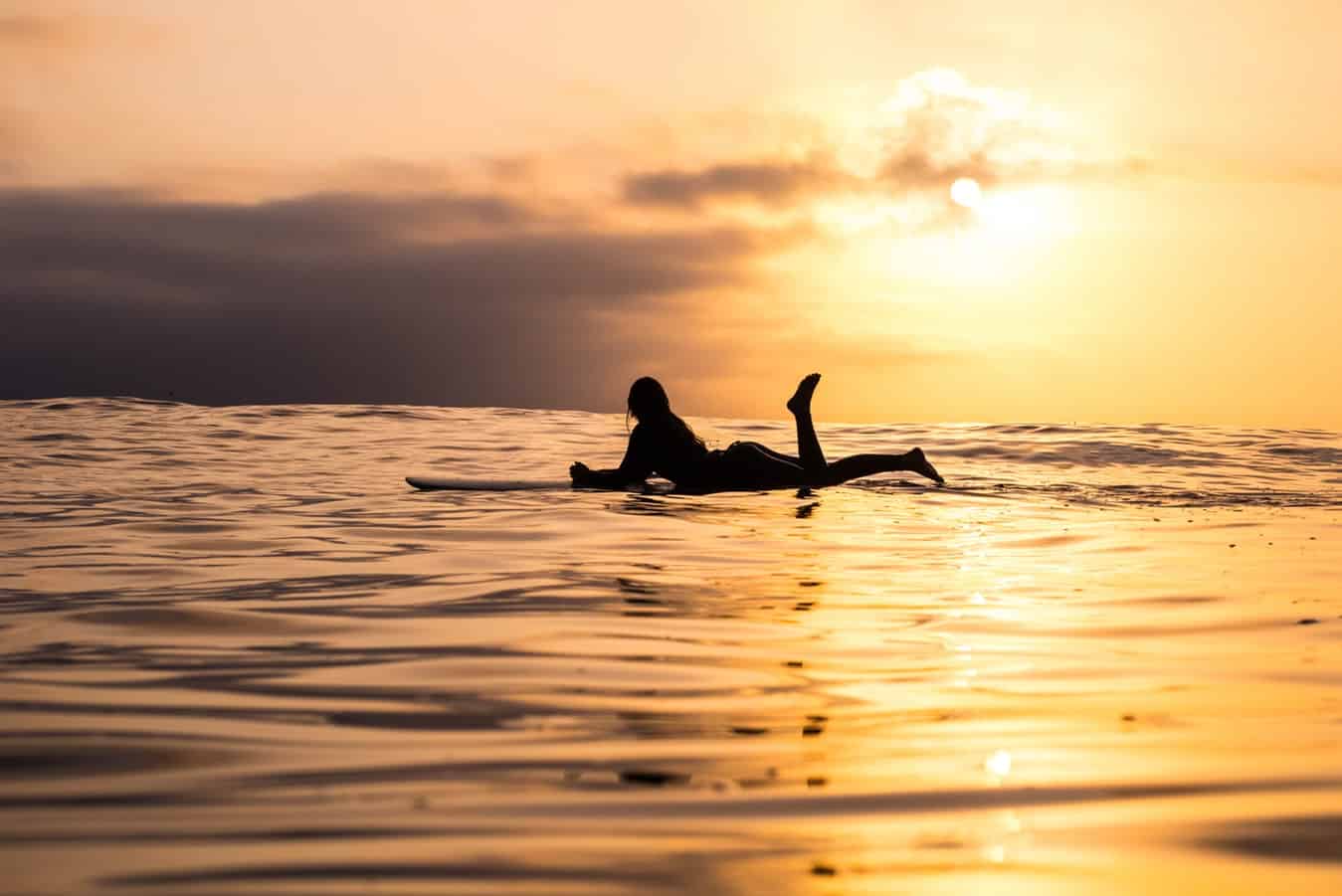Surfing is an insanely fun sport for many reasons. It’s a great way to stay in shape, enjoy the beach and be part of a great community.
So why is surfing so addictive? Surfing is addicting because of the stimuli your brain experiences, the community you become part of and the philosophy behind the sport.
The combination of these things makes surfing not only fun but leaves you wanting more after every session.
Is Surfing A Good Exercise?
Surfing is a fantastic way to get in shape and stay that way. In addition to providing a good cardio workout from paddling over waves (it really gets your heart pounding), surfing is a complete body workout. Paddling itself mostly develops muscles in the upper back muscles and the deltoids or shoulders. Surfing also provides a great workout for your chest, legs and abdomens. Like swimming itself surfing is one of the most thorough full body workouts you can get from a sport. And when you feel good, you want to keep feeling good. And the tan doesn’t hurt either.
How Does The Surf Community Fuel What Makes It Fun?
Though I’m wary to overgeneralize anything, I feel confident saying the surf community is one the warmest and most open communities you’ll find around. A big part of surf culture is speculating about the uncertainties of surfing itself but also conversing about the big questions one has while waiting for waves beyond the break. The act of surfing is somewhat spiritual and that includes the meditative period sitting on boards waiting for the perfect wave to finally call your name. And when it does, best believe your fellow riders will be cheering you on all the way back to shore.
What’s Happening In Your Brain While You Surf?
Speaking of feeling good, a big part of the addictive factor of surfing is the chemicals your brain produces while you surf. The first chemical is endorphin, something you’ve probably heard associated with nearly every kind of exercise. That’s because when you exercise, your body releases endorphins, which interact with the receptors in your brain that reduce your perception of pain. Endorphins also trigger a positive feeling in the body, similar to that of morphine but unlike morphine actually stimulates you.
Is Surfing An Adrenaline Rush?
Another chemical that your brain produces while surfing is adrenaline. Part of what makes surfing so satisfying is the contrast of patiently waiting for a wave and the adrenaline your brain produces when you enter the rollercoaster that is dropping into a wave. Adrenaline or epinephrine is known as the fight or flight hormone. Once released, adrenaline gives your muscles a boost of energy, reduces pain and causes your body to move involuntarily. The adrenaline surfing produces will provide the beneficial effects of adrenaline without the intense aftermath.

What Other Brain Chemicals Does Surfing Cause?
Dopamine is another chemical your brain produces when you surf. Dopamine is known as the feel-good neurotransmitter. It’s a chemical that ferries information between neurons and contributes to feelings of pleasure and satisfaction as part of the reward system. This important neurochemical boosts mood, motivation and attention as well as helping regulate movement, learning, and emotional responses. It’s hard to describe the sensation after catching a nice wave, but it’s fair to say it’s extremely satisfying and dopamine is the scientific why it feels that way.
Your brain also produces serotonin when you surf. Serotonin is known as the body’s natural mood stabilizer. It’s a chemical that helps with sleeping, eating as well as reduce depression regulate anxiety and even heal wounds. This not only produces a pleasant feeling when surfing, but also improves your mind and body’s health moving forward.
How Does The Philosophy of Surfing Explain Why It’s Addicting?
To begin this answer I’d like to start with a quote from Laird Hamilton, a world famous surfer and crossover innovator who’s invented things like tow-in surfing and paddle boarding. As Laird puts it, “”Surfing’s one of the few sports that you look ahead to see what’s behind.” Part of the thrill of surfing is there no exact science to it. You can look at surf reports, you can practice everyday but at the end of it all, the ocean is beautifully unpredictable. Your first wave might be the best one you get all day. You might wait beyond the break all day and not catch a single thing. That’s because it’s not about the waves you catch on any given day. It’s about the journey.
What Is the Surfer’s Journey?
Sometimes surfing is slow. Sometimes it’s fast. Just like life. And like life, that uncertainty is part of the journey surfers take every time they put their boards in the water. And it’s not just surfers who think that. To quote the 19th-century Irish physicist, John Lyndall “Life is a wave, which in no two consecutive moments of its existence is composed of the same particles.” This is true for actual waves in the ocean. No two waves will ever be exactly alike down to the molecular level.
How Do You Get The Surfing Bug?
To answer this question, I must first reminisce on the first time I set foot on a board. Truth be told, my surfing experience is unique because I actually learned to windsurf and downhill skate on a longboard years before catching a wave.
So with a little experience and the balance pretty much down, I embarked on a trip to Nosara, Costa Rica where I took lessons at Playa Guiones, one of the most consistent beaches in the world in terms of quality waves. After learning to pop up on the beach and having some success getting up on the white water, it was time to go beyond the break.
The process of getting beyond the break isn’t pretty at first. In some ways, it never is. This is because there’s no other way to get out there than swimming hard and turning over your board or “turtling” when a wave crashes onto you. It’s tiring but again, there’s no way around it.
Once you get beyond the break it’s surprisingly calm. The water looks flat as you sit on what feels like the edge of the universe. Then that tranquil blanket of saltwater becomes bumpy. Sometimes they break near you; sometimes they break miles down the coast. It doesn’t always happen the first day, the second or the third, but sometimes that bump of water turns into what seems like a giant blue cliff. “Swim! SWIM FAST!” your instructor says.
It’s bigger than you thought. It’s taller than your entire body; you swim to the end of the cliff. You pop up. Woah. Surfers always seem chill and laid back. But this is FAST. You ride your board through air for what feels like forever. You land. You balance out. You don’t even know which way the waves crashing so you guess. And lucky you, you guess right. You ride it all the way into the white water. You finally fall off your board because your ride has slowed down to its natural conclusion. The saltwater somehow feels fresh on your face and you can’t contain your smile. You get it now.
What Is The Chase For The Perfect Wave?
If you’ve spent any time with surfers you may have heard the mythical term known as “The Perfect Wave”. Silly as it seems, this concept is actually a huge reason why surfing is so addictive. As the surfers in the film The Endless Summer highlight, once you get deep into surf culture, the perfect wave becomes your own personal holy grail. Everyday you go out, you’re hoping it’ll be the one. But there is no “one”. Every wave is different than the last. And they’re gone just as fast they appear. As renowned author and fellow surfer William Finnegan once said,
“Surfers have a perfection fetish. The perfect wave, etcetera. There is no such thing. Waves are not stationary objects in nature like roses or diamonds. They’re quick, violent events at the end of a long chain of storm action and ocean reaction. Even the most symmetrical breaks have quirks and a totally specific, local character, changing with every shift in tide and wind and swell.”
Surfers know there’s no such thing as the perfect wave. But that’s part of it. Part of the journey. And why it’s so addictive. To chase what cannot be caught. That’s what makes us surfers.

